Cite this document
(“The Branch Davidians Research Paper Example | Topics and Well Written Essays - 1750 words”, n.d.)
The Branch Davidians Research Paper Example | Topics and Well Written Essays - 1750 words. Retrieved from https://studentshare.org/psychology/1444467-discuss-a-specific-topic-controversy-related-to
The Branch Davidians Research Paper Example | Topics and Well Written Essays - 1750 words. Retrieved from https://studentshare.org/psychology/1444467-discuss-a-specific-topic-controversy-related-to
(The Branch Davidians Research Paper Example | Topics and Well Written Essays - 1750 Words)
The Branch Davidians Research Paper Example | Topics and Well Written Essays - 1750 Words. https://studentshare.org/psychology/1444467-discuss-a-specific-topic-controversy-related-to.
The Branch Davidians Research Paper Example | Topics and Well Written Essays - 1750 Words. https://studentshare.org/psychology/1444467-discuss-a-specific-topic-controversy-related-to.
“The Branch Davidians Research Paper Example | Topics and Well Written Essays - 1750 Words”, n.d. https://studentshare.org/psychology/1444467-discuss-a-specific-topic-controversy-related-to.


